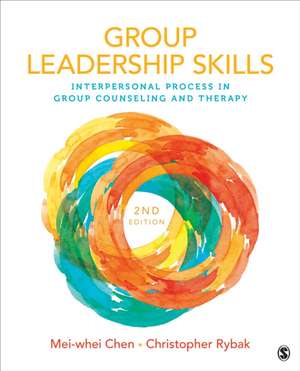Group Leadership Skills: Interpersonal Process in Group Counseling and Therapy
Autor Mei-whei Chen, Christopher J. Rybaken Limba Engleză Paperback – 24 ian 2018
Preț: 1089.76 lei
Preț vechi: 1147.11 lei
-5% Nou
208.59€ • 226.65$ • 175.33£
Carte disponibilă
Livrare economică 31 martie-14 aprilie
Livrare express 14-20 martie pentru 51.91 lei
Specificații
ISBN-10: 1506349307
Pagini: 608
Dimensiuni: 187 x 232 x 20 mm
Greutate: 0.89 kg
Ediția:Second Edition
Editura: SAGE Publications
Colecția Sage Publications, Inc
Locul publicării:Thousand Oaks, United States
Recenzii
“The first edition of Chen and Rybak was invaluable for my master’s level counseling students, and given the great attention that the authors have paid to suggestions for revisions, I am confident that students and faculty of group counseling will find the second edition even more valuable in moving students comfortably into working with groups.”
“The authors of this textbook provide both a comprehensive and practical understanding of the group counseling process for both entry level group leaders and seasoned group leaders. Special attention is used to describe the various types of challenges one face with working with individuals in a group setting. Most impressively, the authors provide an opportunity for entry level counselors to consider their role as the group leader and assessment of personal and professional growth.”
“This text revision expands on previous available materials, is accessible to undergraduate and graduate students, and has practical examples to illuminate the concepts.”
“In Group Leadership Skills, Chen and Rybak provide a thoughtful, nuanced, and honest look into the interpersonal relationship world of group counseling and therapy. They weave the skills new group leaders need in order to be successful throughout very real situations that occur in group work. Group work teachers who create, or want to create, inter- and intrapersonal learning within their classrooms and in their students will find this book a delight. The writing style and the content foster the responsibility of the group leader to be the healthy professional there to guide members to healthy change. This book will challenge students not only to work on their skills as leaders and their understanding of group work, but also on their personal growth and ‘self as instrument.’”
“A deep dive into facilitating group process that helps guide leaders into how to create meaningful change through group interaction.”
“Excellent information and application for upper-level group courses.”
Cuprins
Acknowledgments
About the Authors
Chapter 1. Theories and Assumptions
Sullivan’s Interpersonal Theory
Experiential Theory
Object Relations Theory
Family Systems Theory
Brief Therapy
Strength-Based Therapy
Interpersonal Neurobiology
Underlying Assumptions
Keys to Success in Leading Today’s Groups
Self-Reflection
Chapter 2. On Becoming a Group Leader
The Development of a Leader
Ideal Qualities of an Effective Group Leader
The Five Phases of Group Leader Development
Three Models of Co-Leadership Practice
Seven Principles of Co-Leadership Practice
Cultivating Your Inner Leader
Starting a Journey to Your Own Inner Peace
Self-Reflection
Chapter 3. Types of Groups and How to Start One From Scratch
Ethical and Professional Guidelines
Types of Groups Not Facilitated by Credentialed Professionals
Types of Groups Led by Credentialed Professionals
Starting a Group From Scratch (I): Program Planning
Starting a Group From Scratch (II): Pregroup Orientation
Starting a Group From Scratch (III): Criteria for Member Selection
Starting a Group From Scratch (IV): Screening Interview
Cases in Point: Screening Interview Notes
Exercises
Chapter 4. Fundamental Skills for Group Facilitation and Intervention
Group Facilitation and Intervention
Leader as Observer-Participant
Basic Principles of Facilitation and Intervention
Basic Facilitation Skills (I): How to Open a Group Session
Basic Facilitation Skills (II): How to Increase Group Mutual Engagement
Basic Intervention Techniques (I): Blocking and Redirecting
Basic Intervention Techniques (II): Refocusing and Correcting
Basic Facilitation Skills (III): Closing a Group Session
Exercises
Chapter 5. The First Session and the Forming Stage
Leadership and the Forming Stage
Leadership Skills for the First Session
Special Considerations for the First Session
Reflections on the First Session
An Overview of the Flow and Time Frame of the First Session
Exercises
Chapter 6. Leading Structured Group Sessions
Mandated Groups: How to Make Them Work
I. Structured Exercises for Mandated Groups
II. Structured Exercises for Psychoeducational Groups
III. Structured Exercises for Counseling Groups
Misuse of Structured Exercises
How to Conduct Structured Exercises
How to Process After Structured Exercises
Other Considerations During Processing
Various Examples of Structured Communication Exercises
Cases in Point: Participant Reflections on Structured Exercises
An Overview of the Flow and Time Frame of a Structured Session
Exercises
Chapter 7. Leading Semistructured Groups: Working on Agenda Items
Features of Semistructured Groups
Getting Agenda Contracts
Toward a More Personal Level of Self-Disclosure
Facilitating a Safe and Supportive Group Interaction
Facilitating Giving There-and-Then Feedback
Intervention Techniques
Cases in Point
An Overview of the Session Flow and Time Frame of a Semistructured Group Session
Exercises
Chapter 8. Unstructured Groups—Basic Level
Features of Unstructured Groups
Leadership Principles of Unstructured Groups
Easing Members Into Self-Disclosure by Working on Multiple Member Concerns
Methods of Working on Multiple Member Concerns Simultaneously
Low-Intensity Here-and-Now Disclosure
Baby Steps Toward Here-And-Now Feedback
Making Meanings Out of Difficult Life Experiences
Intervention Techniques for Unstructured Groups—Basic Level
A Case In Point
An Overview of the Flow and Time Frame of a Basic Level Unstructured Session
Exercises
Chapter 9. Working With Unspoken Tension and Open Conflict
The Transition Stage and Member Dissatisfaction
Culture/Diversity Factors and Unspoken Tension
Options for Managing Unspoken Tension
Member Negative Transference to the Leader
Methods of Handling Negative Member Transference
Leaders’ Own Countertransference and How to Handle It
Guidelines for Leader Self-Disclosure
The Paradox of Open Conflicts
Seven Steps of Conflict Resolution
The Group Leader’s Self-Care
Cases in Point
Exercises
Chapter 10. Taking Risks in Communication
The Norming Stage of the Group
Intimacy, Cohesiveness, and High-Quality Communication
Self-Disclosure and How to Deepen It
Feedback-Giving and How to Maximize Its Power
Intermediate Steps Toward the Here-and-Now
Leader Participation in Here-and-Now Feedback and Impact Disclosure
Seven Principles of Constructive Confrontation
How to Deal With Poor Confrontation
Group Members’ Reflection on Confrontation
Coaching Members to Request and Receive Feedback
Cases in Point
Exercises
Chapter 11. Advanced Steps Into the Here-and-Now
The Working Stage and Unstructured Groups—Advanced Level
The Here-and-Now Method and the Process Level of Communication
The Here-and-Now Method: The Two Tiers
Key to the Here-And-Now Method: Zigzagging the Hot Seat
The Principles of Engaging the First Tier: Stimulating Group Affects
Behavioral Markers for Group Affect Stimulation
(I) Medium-Intensity Stimulation: Members Setting Here-and-Now Session Goals
(II) High-Intensity Stimulation: Revealing In-Group Perceptions
(III) Even Higher-Intensity Stimulation: Hypothetical Role Enactment
(IV) Highest-Intensity Stimulation: Hypothetical Grading
An Overview of an Unstructured Session With a Here-and-Now Focus
Exercises
Chapter 12. Process Illumination
Process Illumination and Change
Ways to Recognize Group Processes
Tips for Process Illumination
The Five Components of Process Illumination: The Leader’s Course of Action
Process Illumination Technique (I): Go After Reactivity Markers
Process Illumination Technique (II): Uncovering Hidden Meanings
Process Illumination Technique (III): Make the Invisible Visible
Process Illumination Technique (IV): Explore the Meanings of Behaviors Engaged by “Dyads, “Triads,” or “the Group as a Whole”
Process Illumination Technique (V): Link Here-and- Now to There-and-Then
A Case in Point
Exercises
Chapter 13. Using Psychodrama for Unresolved Pain
The Power of Psychodrama in Therapy
Basic Concepts of Psychodrama Applicable to Group Practice
Maximizing the Group’s Healing Power With Psychodrama Techniques
A Detailed Case
Exercises
Chapter 14. Skills of Termination: Completing the Cycle
Dealing With Uncommon Termination
The Termination Stage of a Typical Group
Seven Principles of Termination
Skills for Ending the Group
Evaluation of the Group Experience
Examples of Looking-Back Letters
Exercises
Chapter 15. Writing as a Reflective Practice in Group Counseling
Leaders’ Reflective Practice
Member’s Reflective Practice
Applying Reflective Journaling in Group Counseling
Leaders’ Narrative Session Notes
Using Therapeutic Language in Narrative Session Notes
Appendices
Appendix A: A Sample of the Group Proposal
Appendix B: Pregroup Orientation Handouts
Appendix C: Examples of Interpersonal Skills for Member to Practice in the Session
Appendix D: Examples of Brief Relaxation Exercises for Opening the Group
References
Index
Notă biografică
Dr. Chen is a professor at Northeastern Illinois University. She teaches group counseling, individual counseling, theories in counseling and
psychotherapy, mental health counseling, grief counseling, and stress management. In addition, she maintains her own private practice, on the
side, in Illinois.
She has received three Faculty Excellence Awards from Northeastern Illinois University. As well, she received the Beverly Brown Award for Outstanding Contributions to the Field of Group Counseling from the Illinois Association for Specialists in Group Work (IASGW).
Besides the text of Group Leadership Skills, Dr. Chen also publishes Individual Counseling and Therapy: Skills and Techniques (3rd edition coming out in 2018) and has published many journal articles in related areas.























